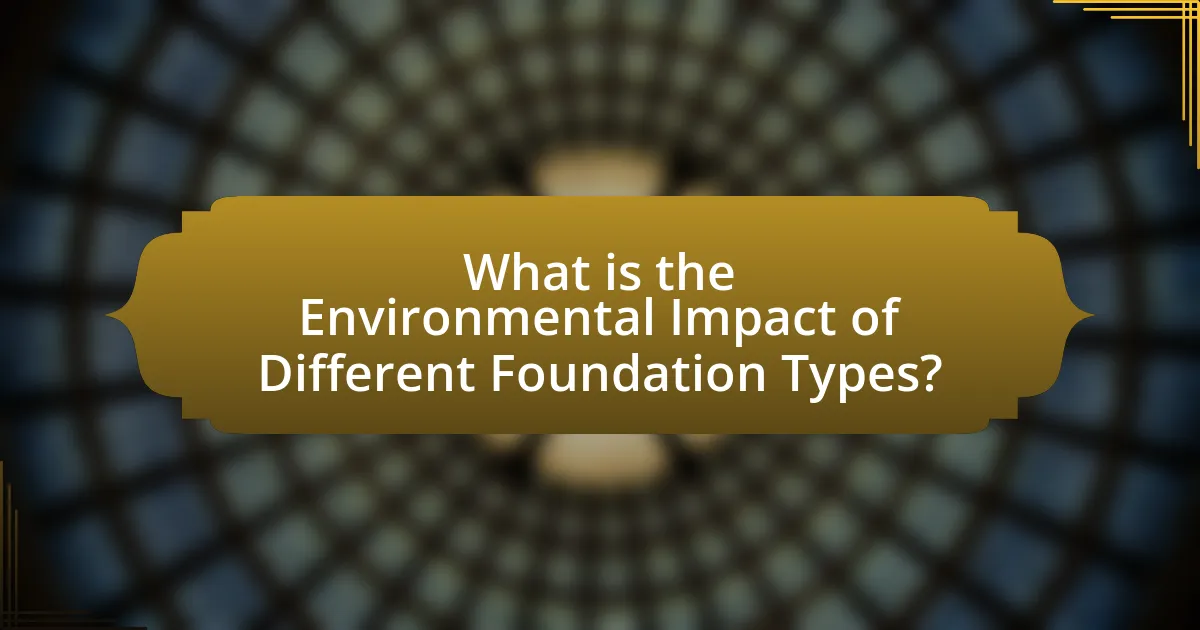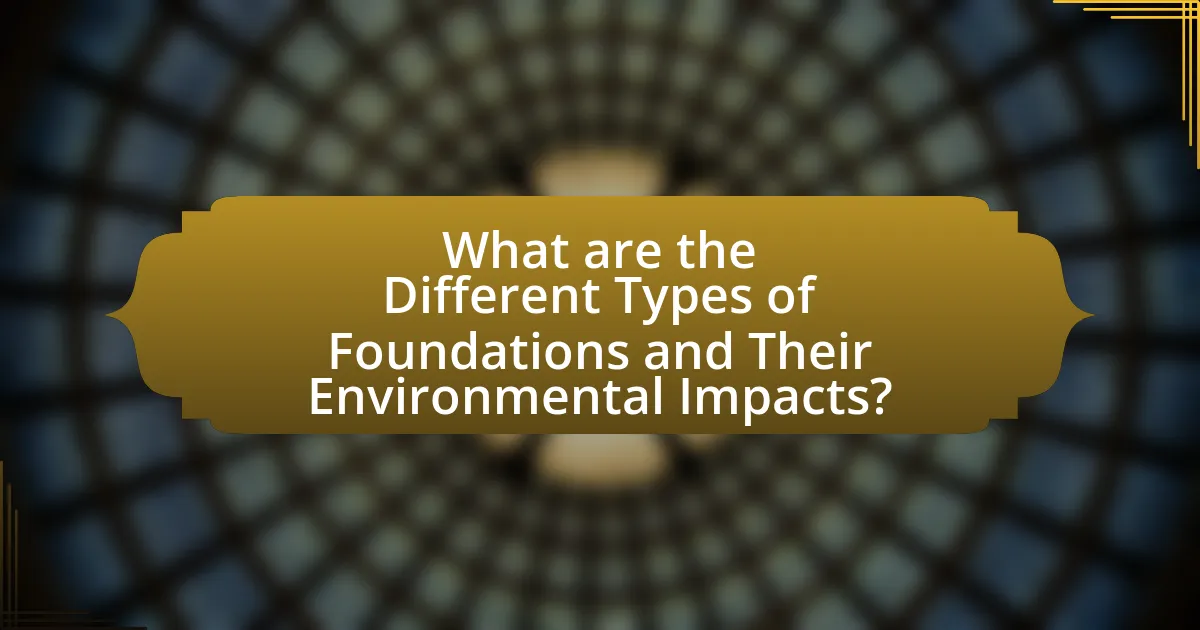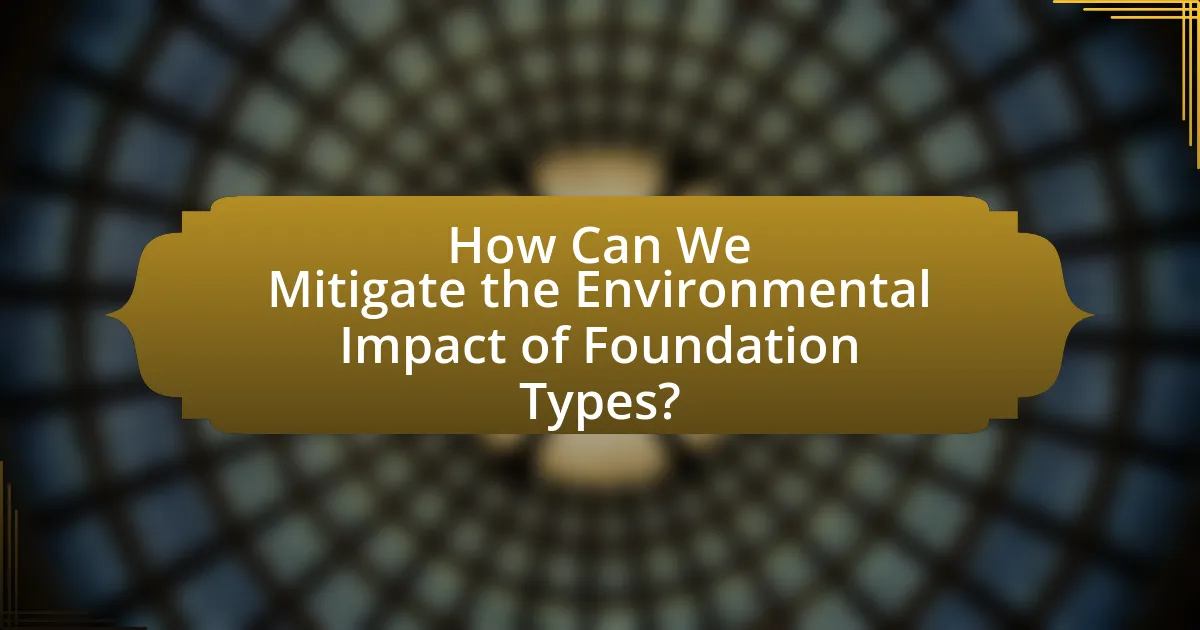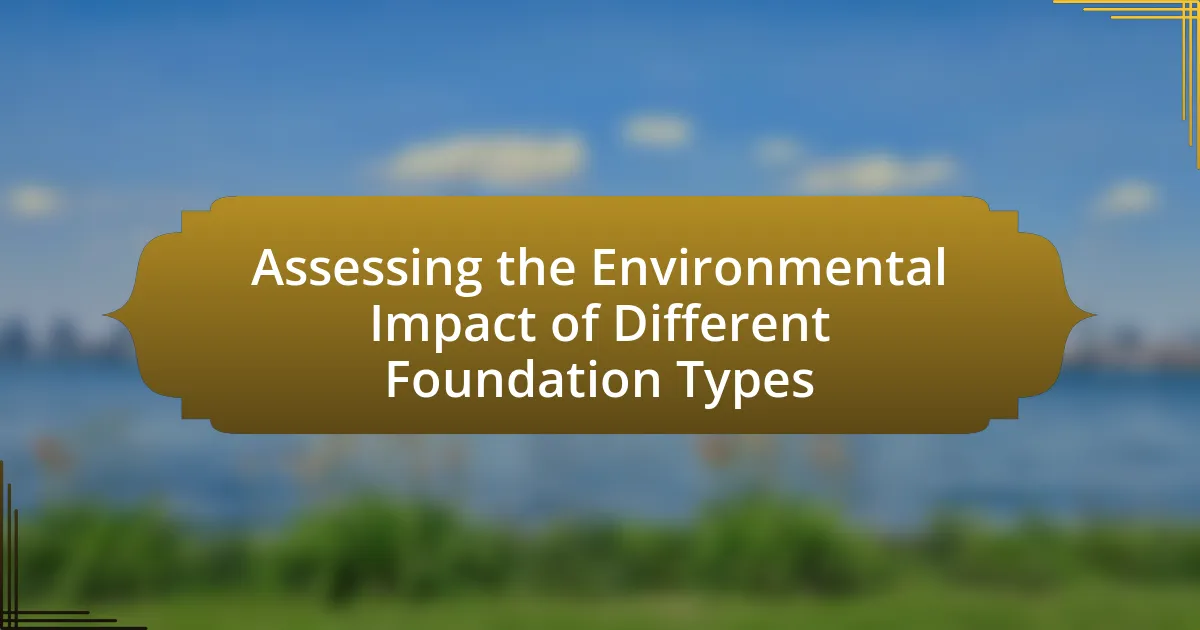The article focuses on assessing the environmental impact of different foundation types, highlighting how materials and construction methods influence sustainability. It examines the ecological consequences of concrete, timber, shallow, and deep foundations, emphasizing factors such as carbon emissions, soil stability, and ecosystem disruption. The discussion includes the benefits of using sustainable materials and innovative techniques to mitigate environmental damage, as well as the importance of environmental assessments in guiding construction practices. Key metrics for evaluating foundation impacts and emerging trends in eco-friendly foundation design are also addressed, providing a comprehensive overview of the relationship between foundation types and environmental sustainability.

What is the Environmental Impact of Different Foundation Types?
The environmental impact of different foundation types varies significantly based on materials used and construction methods. For instance, concrete foundations contribute to carbon emissions due to the cement production process, which accounts for approximately 8% of global CO2 emissions. In contrast, timber foundations, while renewable, can lead to deforestation if sourced unsustainably. Additionally, deep foundations, such as piles, can disrupt local ecosystems and groundwater flow, whereas shallow foundations typically have a lower ecological footprint. Research indicates that using recycled materials in foundation construction can mitigate some environmental impacts, promoting sustainability in building practices.
How do foundation types influence environmental sustainability?
Foundation types significantly influence environmental sustainability by affecting soil stability, resource consumption, and ecological disruption. For instance, shallow foundations typically require less excavation and material, leading to lower carbon emissions compared to deep foundations, which often necessitate extensive drilling and concrete use. Research indicates that using sustainable materials, such as recycled aggregates in foundation construction, can further reduce the environmental footprint. Additionally, foundations that minimize land disturbance help preserve local ecosystems, as seen in projects that utilize pier foundations, which leave more of the natural landscape intact. Thus, the choice of foundation type directly impacts the overall sustainability of construction practices.
What are the key environmental factors affected by foundation types?
Foundation types significantly affect soil stability, groundwater flow, and ecosystem disruption. Different foundation designs, such as shallow versus deep foundations, influence how load is distributed and can lead to soil compaction or erosion. For instance, deep foundations may penetrate aquifers, altering groundwater levels and flow patterns, while shallow foundations can lead to increased surface runoff and soil saturation. Additionally, the materials used in foundations, such as concrete or steel, can impact local ecosystems through resource extraction and carbon emissions during production. Studies indicate that the choice of foundation type can lead to varying degrees of environmental degradation, highlighting the importance of selecting appropriate foundation systems based on site-specific conditions.
How do different foundation materials impact the ecosystem?
Different foundation materials significantly impact the ecosystem through their effects on soil composition, water drainage, and local biodiversity. For instance, concrete foundations can lead to increased surface runoff and reduced groundwater recharge, which disrupts local hydrology and can contribute to erosion and habitat loss. In contrast, wooden foundations may have a lesser impact on drainage but can introduce risks of decay and pest infestations that affect surrounding flora and fauna. Research indicates that the choice of foundation material can influence soil health; for example, studies show that permeable materials promote better water infiltration and support diverse microbial communities, enhancing soil fertility. Therefore, the selection of foundation materials is crucial for minimizing ecological disruption and promoting sustainable land use practices.
Why is it important to assess the environmental impact of foundation types?
Assessing the environmental impact of foundation types is crucial because it informs sustainable construction practices. Different foundation types can significantly affect soil stability, water drainage, and local ecosystems. For instance, shallow foundations may lead to increased soil erosion, while deep foundations can disrupt groundwater flow. Understanding these impacts allows engineers and architects to choose foundation designs that minimize ecological damage, promote resource conservation, and comply with environmental regulations. Studies have shown that environmentally conscious foundation choices can reduce construction waste by up to 30%, highlighting the importance of this assessment in achieving sustainable development goals.
What are the long-term consequences of ignoring environmental assessments?
Ignoring environmental assessments can lead to severe long-term consequences, including ecological degradation, loss of biodiversity, and increased vulnerability to climate change. For instance, without proper assessments, construction projects may disrupt local ecosystems, resulting in habitat destruction and species extinction. A study by the United Nations Environment Programme highlights that projects lacking environmental evaluations often lead to irreversible damage, such as soil erosion and water pollution, which can persist for decades. Additionally, communities may face health risks due to exposure to pollutants, as seen in areas where industrial activities proceeded without environmental scrutiny. These consequences underscore the critical importance of conducting thorough environmental assessments to safeguard ecosystems and public health.
How can environmental assessments guide construction practices?
Environmental assessments can guide construction practices by identifying potential environmental impacts and informing decision-making processes. These assessments evaluate factors such as soil stability, water quality, and biodiversity, which are crucial for selecting appropriate foundation types. For instance, a study by the Environmental Protection Agency indicates that thorough environmental assessments can reduce negative impacts by up to 30%, ensuring that construction practices align with sustainability goals and regulatory requirements. By integrating these assessments into planning, construction projects can minimize ecological disruption and promote responsible resource use.

What are the Different Types of Foundations and Their Environmental Impacts?
The different types of foundations include shallow foundations, deep foundations, and specialized foundations, each with distinct environmental impacts. Shallow foundations, such as spread footings and mat foundations, typically have a lower environmental impact due to minimal excavation and reduced soil disturbance. However, they can lead to increased surface runoff and soil erosion if not managed properly. Deep foundations, including piles and drilled shafts, require extensive excavation and can disrupt local ecosystems, potentially leading to habitat loss and increased sedimentation in nearby water bodies. Specialized foundations, like caissons, may also have significant environmental impacts due to their construction methods, which can affect groundwater flow and soil stability. Studies indicate that the choice of foundation type can influence not only construction costs but also long-term environmental sustainability, emphasizing the need for careful site assessment and planning to mitigate adverse effects.
How do shallow foundations compare to deep foundations in terms of environmental impact?
Shallow foundations generally have a lower environmental impact compared to deep foundations. This is primarily due to their reduced material usage and less intensive construction processes, which lead to lower carbon emissions. For instance, shallow foundations typically require less excavation and fewer materials, resulting in less disruption to the surrounding ecosystem. In contrast, deep foundations often necessitate extensive drilling and the use of heavier machinery, which can contribute to soil degradation and increased noise pollution. Studies indicate that shallow foundations can reduce the overall carbon footprint of construction projects by up to 30% compared to deep foundations, highlighting their more sustainable nature in terms of environmental impact.
What are the specific environmental concerns associated with shallow foundations?
Shallow foundations pose specific environmental concerns primarily related to soil erosion, groundwater contamination, and habitat disruption. Soil erosion can occur due to the excavation and grading processes required for shallow foundations, leading to sediment runoff that affects nearby water bodies. Groundwater contamination is a risk when construction activities disturb soil layers, potentially allowing pollutants to leach into aquifers. Additionally, shallow foundations can disrupt local ecosystems by altering land use and displacing flora and fauna, which can lead to a loss of biodiversity. These concerns highlight the need for careful planning and environmental assessments during the design and construction of shallow foundations.
What are the specific environmental concerns associated with deep foundations?
Deep foundations pose several specific environmental concerns, primarily related to soil disturbance, groundwater contamination, and habitat disruption. The installation process often requires extensive excavation and drilling, which can lead to soil erosion and sediment displacement, negatively impacting local ecosystems. Additionally, the use of heavy machinery and the potential for spills of hazardous materials during construction can contaminate groundwater sources. Studies have shown that these activities can disrupt the natural habitat of flora and fauna, leading to biodiversity loss. For instance, a report by the U.S. Environmental Protection Agency highlights that construction activities can significantly alter local hydrology and affect surrounding wildlife habitats.
What role do innovative foundation types play in reducing environmental impact?
Innovative foundation types significantly reduce environmental impact by minimizing land disturbance and optimizing material use. These foundations, such as screw piles and helical piers, require less excavation and soil displacement compared to traditional concrete foundations, thereby preserving the surrounding ecosystem. For instance, screw piles can be installed with minimal vibration and noise, which protects local wildlife habitats. Additionally, the use of recycled materials in some innovative foundation designs further decreases the carbon footprint associated with construction. Studies indicate that these methods can reduce greenhouse gas emissions by up to 30% compared to conventional foundations, demonstrating their effectiveness in promoting sustainable building practices.
How do sustainable materials in foundation construction affect the environment?
Sustainable materials in foundation construction positively affect the environment by reducing carbon emissions and minimizing resource depletion. For instance, using recycled concrete and sustainably sourced timber can lower the overall carbon footprint of construction projects. According to a study published in the Journal of Cleaner Production, utilizing recycled materials can reduce greenhouse gas emissions by up to 30% compared to traditional materials. Additionally, sustainable materials often require less energy for production, further decreasing environmental impact. This approach not only conserves natural resources but also promotes a circular economy, enhancing ecological sustainability in the construction industry.
What are the benefits of using alternative foundation techniques?
Alternative foundation techniques offer several benefits, including reduced environmental impact, cost-effectiveness, and improved adaptability to various soil conditions. These techniques, such as screw piles and helical piers, minimize soil disturbance and reduce the carbon footprint associated with traditional concrete foundations. For instance, a study by the National Institute of Standards and Technology found that using alternative foundations can decrease construction waste by up to 30%, highlighting their efficiency. Additionally, these methods often require less excavation and can be installed in challenging terrains, making them suitable for diverse construction projects.

How Can We Mitigate the Environmental Impact of Foundation Types?
To mitigate the environmental impact of foundation types, engineers can utilize sustainable materials and innovative construction techniques. For instance, using recycled aggregates and low-carbon concrete can significantly reduce the carbon footprint associated with foundation construction. Additionally, implementing techniques such as soil stabilization and minimizing excavation can preserve local ecosystems and reduce land disturbance. Research indicates that adopting these practices can lower greenhouse gas emissions by up to 30% compared to traditional methods, demonstrating their effectiveness in reducing environmental impact.
What best practices can be implemented to minimize environmental damage?
Implementing best practices such as using sustainable materials, optimizing energy efficiency, and minimizing land disturbance can significantly reduce environmental damage. Sustainable materials, like recycled steel and low-impact concrete, lower carbon footprints during construction. Optimizing energy efficiency through design and technology reduces resource consumption and emissions over the building’s lifecycle. Minimizing land disturbance by employing techniques like careful site selection and erosion control preserves local ecosystems and biodiversity. According to the U.S. Green Building Council, buildings that follow these practices can reduce energy use by up to 30% and water use by 20%, demonstrating their effectiveness in minimizing environmental impact.
How can site selection influence the environmental impact of foundations?
Site selection significantly influences the environmental impact of foundations by determining the ecological characteristics and resources of the location. Choosing a site with minimal disturbance to existing ecosystems can reduce habitat destruction, soil erosion, and water runoff. For instance, selecting a location that avoids wetlands or protected areas helps preserve biodiversity and maintain natural water filtration systems. Additionally, sites with stable soil conditions can minimize the need for extensive excavation and material use, thereby lowering carbon emissions associated with construction activities. Research indicates that strategic site selection can lead to a reduction in the overall environmental footprint of construction projects, as it directly affects land use, resource consumption, and the potential for pollution.
What construction techniques can reduce the ecological footprint of foundations?
Construction techniques that can reduce the ecological footprint of foundations include the use of reinforced earth, helical piles, and rammed earth foundations. Reinforced earth combines soil with geosynthetic materials, minimizing the need for concrete and reducing carbon emissions associated with traditional foundations. Helical piles, which are screw-like steel foundations, require less excavation and can be installed with minimal disturbance to the surrounding environment, thus preserving local ecosystems. Rammed earth foundations utilize natural materials and have a lower embodied energy compared to conventional concrete, contributing to a smaller ecological footprint. These techniques not only enhance sustainability but also align with modern environmental standards in construction.
What tools and methods are available for assessing foundation impacts?
Tools and methods available for assessing foundation impacts include geotechnical investigations, environmental impact assessments (EIAs), and modeling software. Geotechnical investigations utilize soil sampling and testing to evaluate the physical properties of the ground, which informs foundation design and potential impacts. Environmental impact assessments systematically analyze the potential environmental effects of foundation construction, considering factors such as soil erosion, water quality, and habitat disruption. Additionally, modeling software, such as finite element analysis tools, allows engineers to simulate the behavior of foundations under various conditions, providing insights into structural integrity and environmental interactions. These methods are validated by industry standards and regulatory requirements, ensuring comprehensive evaluation of foundation impacts.
How can environmental impact assessments be effectively conducted?
Environmental impact assessments can be effectively conducted by following a systematic process that includes scoping, data collection, impact analysis, and stakeholder engagement. This structured approach ensures that all potential environmental effects of a project are identified and evaluated comprehensively. For instance, the scoping phase defines the key issues to be assessed, while data collection involves gathering relevant environmental data, such as biodiversity, water quality, and air pollution levels. Impact analysis then evaluates how the proposed project may affect these environmental factors, and stakeholder engagement ensures that community concerns and insights are incorporated into the assessment. Research indicates that projects with thorough environmental impact assessments are less likely to encounter significant legal challenges and can lead to more sustainable outcomes, as demonstrated by a study published in the Journal of Environmental Management, which found that effective assessments reduce negative environmental impacts by up to 30%.
What metrics are used to evaluate the environmental impact of foundation types?
Metrics used to evaluate the environmental impact of foundation types include carbon footprint, energy consumption, material sustainability, and land use change. The carbon footprint measures greenhouse gas emissions associated with the production and installation of foundation materials. Energy consumption assesses the total energy required throughout the lifecycle of the foundation, from extraction to installation. Material sustainability evaluates the renewable or recycled content of materials used, while land use change examines the ecological effects of altering land for foundation construction. These metrics provide a comprehensive framework for understanding the environmental implications of different foundation types.
What are the future trends in foundation types and their environmental considerations?
Future trends in foundation types emphasize sustainability and reduced environmental impact. Innovations such as using recycled materials, like crushed concrete and steel, are gaining traction to minimize resource consumption. Additionally, the adoption of deep foundations, such as screw piles and helical piers, is increasing due to their lower disturbance to the surrounding ecosystem compared to traditional methods. Research indicates that these methods can significantly reduce soil erosion and habitat disruption, aligning with global sustainability goals. Furthermore, the integration of smart technologies in foundation design allows for real-time monitoring of environmental conditions, enhancing the adaptability of structures to climate change impacts.
How is technology shaping the development of eco-friendly foundations?
Technology is significantly shaping the development of eco-friendly foundations by enabling the use of sustainable materials and innovative construction techniques. Advanced materials such as recycled concrete, bamboo, and bio-based composites reduce environmental impact while enhancing structural performance. Additionally, technologies like Building Information Modeling (BIM) facilitate efficient design processes, allowing for better resource management and minimizing waste during construction. Research indicates that using these technologies can lead to a reduction in carbon emissions by up to 30% compared to traditional methods, demonstrating their effectiveness in promoting sustainability in foundation development.
What innovations are emerging in foundation design to enhance sustainability?
Innovations in foundation design that enhance sustainability include the use of recycled materials, modular construction techniques, and advanced soil stabilization methods. Recycled materials, such as crushed concrete and industrial by-products, reduce waste and lower the carbon footprint of foundations. Modular construction techniques allow for prefabrication off-site, minimizing material waste and construction time. Advanced soil stabilization methods, such as biopolymer injections, improve soil strength and reduce the need for extensive excavation, further decreasing environmental impact. These innovations collectively contribute to more sustainable construction practices and align with global efforts to reduce carbon emissions in the building sector.
What practical steps can builders take to assess and improve foundation sustainability?
Builders can assess and improve foundation sustainability by conducting a thorough site analysis, utilizing sustainable materials, and implementing efficient construction practices. A site analysis involves evaluating soil conditions, hydrology, and local ecosystems to determine the most suitable foundation type, which can minimize environmental disruption. Using sustainable materials, such as recycled aggregates or low-carbon concrete, reduces the carbon footprint associated with foundation construction. Additionally, implementing efficient construction practices, such as minimizing waste and optimizing energy use during the building process, further enhances sustainability. These steps are supported by studies indicating that sustainable building practices can significantly reduce environmental impacts, such as the research published in the Journal of Cleaner Production, which highlights the benefits of eco-friendly materials and methods in construction.

Leave a Reply